-
Posts
1,762 -
Joined
-
Last visited
Content Type
Profiles
Forums
Store
Help Articles
Posts posted by Wholemeal Crank
-
-
I've had a couple of long grain red rices, some from Thailand and at least one from India, that were quite delicious, reminding me a lot of Basmati. I do buy them from time to time as a treat, but need to limit the varieties I keep on hand because I don't go through it fast enough.
-
So far Monday just two teas: some 'Drum mountain white cloud tea' (a gift to a tea friend who shared it), light and delicate white tea; and now 2006 purple bud Haiwan sheng puerh from Norbu, gongfu cha instead of the more common bulk brewing.
-
Glad to have been of some help.
Your reply prompted me to go back and reread the 'resteeping' topic, and to notice, in retrospect, that I had quite possibly chosen the worst possible tea for such a comparison. One common feature to a lot of nice shu (cooked) puerh, as those Rishi tuo cha surely were, is that the tea tends to not change that much first from first steep to last, at least as compared to sheng (raw) puerh. So the same experiment run with a more interesting tea would likely yield a lot more difference--and without having done lots of head-to-head trials since, I've done plenty of bulk brewings with a tea that shone in gongfu cha, but was was flat, insipid, or downright horrid in the bulk session. Hence, my preferences as noted in my previous post, and caution about taking the results of the pu tuo experiment too seriously.
-
Those look delicious. Glad they worked out so nicely.
-
I like Thai black sticky rice to eat with curries and stir fries, and for making sweet sticky rice dessert with coconut and mangoes, and it makes a terrific breakfast (prepped the night before in the fuzzy rice cooker) when seasoned with some toasted pine nuts and some fresh or dried fruit. I prefer brown basmati for most middle-eastern meals or pilaf-type dishes. I have a weakness for exotic rices, and have tried a bunch of others here and there--red rice from Bhutan and black 'forbidden rice' from China, brown basmatic from India, pecan rice from Louisiana, etc, but the basmatic and the Thai black rice are the staples that I always keep on hand. I also enjoy, but don't always have on hand, the Lundburg Wehani rice and their Black Japonica blend.
The third staple rice I keep in my pantry is short grain 'sweet' brown rice, that I mostly use for baking--10-20% rice flour adds a nice crunch to some cookies etc, but I almost never cook that rice otherwise.
-
Today, sencha start, then some Bai Yun oolong, a very nice thermos full, and a nice ending of spicy tulsi (holy basil) with cassia buds, cardamom, and saffron.
-
A very good series of brewings today: a winter alishan oolong from norbu; silver dragon white tea from wing hop fung; then Korean oolong from Hankook. Had a much better than anticipated bulk brewing of the alishan, and if course kept on with the alishan until the kettle ran dry.
-
Little of this, little of that. Yesterday, started with some Xiang Bi Luo from Wing Hop Fung, a rather random green tea that resembles a Bi Lo Chun, shared with several colleagues--I think I gave them the best of these leaves, from the first infusions, and the last few I drank were kind of 'eh'; then a very long & lovely dialogue with some Da Hong Pao from Norbu, one of those things I'd been craving for a while, many infusions; and ended with another session with a new Dan Cong, Ya Shi, that I did a little better with than the first time, from Tea Habitat.
Today, a rush/bulk brewing of a shu pu from Wing Hop Fung, a nice reliable thermos o' tea under the circumstances (dump in chunk of pu, add hot water, close thermos, wait half an hour, open lid, pour, hope it's drinkable.....and it was); now enjoying the opposite, relaxed gongfu session with "Tsou ma fei" spring Alishan oolong from Norbu. Very nice.
-
Happy book-day to me, happy book-day to me.....books are here, made their cross country journey just fine, although the case was not so lucky (note: these were purchased 'used' and were not in their original packaging). They're very large, and not quite as heavy as I expected, and as beautiful as I'd hoped. I may not surface for a few days after diving in.
-
Raw egg doesn't stop me from eating cookie dough. But I'd think the raw egg white would add an undesirable texture, and possibly flavor as well, to raw graham cracker crust--and that would stop me.
-
I'm intrigued by the idea of adding egg white.
But if you add egg white, you lose the great pleasure of snacking on the last spoonful of extra crumbs, because in your infinite wisdom, you always prepare at least one cracker's extra worth of crust.
-
I bought some once when, pound for pound, they were cheaper than ripe red bell peppers, and used them in a chickpea soup. But mostly I buy them as a couple of weeks' worth of treats for my guinea pig--the tiny size is perfect for the spoiled rotten squee-er.
-
If the dough were chilled before it was shaped, the rolls would warm and thus rise faster than the loaf, but otherwise the rolls should rise just as fast as the loaf.
Baking temp/time is affected by the size, shape, & density (in the pan) of the rolls. A deep pan packed with rolls that merge together as they rise needs nearly the same baking time as a single loaf, and doesn't need a hotter oven; a flat sheet of thin small rolls that stay separate while rising and baking will bake a lot quicker.
-
Started the last couple of days with some Hon Yama Zairai sencha from Norbu--this morning had a particularly fine brewing. I started very cool, 145 degrees, with a longer than usual first infusion, and gradually worked up to 180 degrees by the 6th infusion, and every infusion was delicious, nutty, vegetal, sweet, without noticeable bitterness, and only enough astringency to balance the rest. I wish I'd been taking notes!
Fortunately, I still have a good number of infusions left between the remains of this bag and the one in reserve to get this down better.
And then a variety of teas after that, with a couple of tastings noted in the oolong topic--2009 Winter wood-roasted Shui Xian from HouDe, and 2008 Song Zhong Dan Cong oolong from TeaHabitat. Along the way, some Diamond TGY from Norbu, really packed the gaiwan with excellent results, and I've forgotten at least one other. Lots of tea this weekend, working in the kitchen & office right next to the tea kettle.
-
A bunch of new teas, gray rainy weather, and another tea tasting....
2008 Song Zhong #5
Phoenix Dan Cong Oolong from TeaHabitat,
A first brewing of a spectacular tea. I was intending to reach for my 60mL Chao Zhou pot, having planned on a small series of infusions, but without really paying attention grabbed a larger pot instead. So there were fewer than anticipated infusions because the tea was really quite dilute. Despite that, it really shone.
Sweet, scent of dried apricots from the long, thin, twisted, quite dark brown leaves
Used 1.5g leaf in 100 mL clay pot--which as you can see is not much for the size of the pot
205 degrees, first infusion 20 seconds--still that apricot scent, floral in the first infusion, and the flavor matches--stone fruit with flowers. Oh my oh my.
2nd infusion, 45 seconds, sweet, floral, fruity, more intense with the longer infusion. A touch of spice--cinnamon, mace--on the back of the tongue, along with the floral.
3rd infusion, 45 second, more of the same--floral, fruity.
5th infusion, 1 minute--spicier coming to the fore, with the fruity/floral notes still rounding out the flavor, felt more at the sides of my mouth and in the sweet aftertaste. I open my mouth, inhale though it, and the sweet floral taste remains. I set a part of this apart in the aroma cup, and when I remembered it a couple of minutes later, it had cooled, but still, wow!, it was brilliant.
6th infusion, probably 2-3 minutes, more floral and fruity, didn't drink it slow enough to really process the flavors in great detail.
Setting it aside for a while now, before I float away on this pool of tea inside me.
A 7th infusion again needed more patience. Will go away from the next one for a while, but pour water over the pot to try to keep it hot and brewing….
And 8th at about 6 minutes was clearly demonstrating that the leaves were spent. Sigh. They're still an elegant mix of red edges and green middle.
Can't wait to do this one again with the Chao Zhou pot and double the leaf.
-
Less ambitious today....but it's a chilly gray tea morning.
Trying a more formal tasting for the 2009 Wood-roasted winter Shui Xian from HouDe: 2.5 grams tightly curled leaf, 2.5 oz water in a gaiwan.
30 seconds 1st infusion--sweet, silky, earthy, toasty, warm, a bit too dilute, should have let it go longer, because the warm flavor is there, but nothing else yet.
1 minute 2nd infusion--now the grassy, herbaceous flavors are strong, but not bitter, and it tastes utterly different--chameleon tea! (this is why I am quite in love with it)
30 seconds 3rd infusion--what will it be this time? The hay/straw/warm toasty flavor is still noticeable now, but the grassy top notes are strongly present too. Mmm.
1 minutes 4th infusion--again, a nice mix, a little more of the grassy/herbaceous notes above the warm, toasted finish.
1 minute 5th infusion--very similar.
90 seconds 6th infusion, flavor fading a little, should have been a longer infusion….and can be a longer infusion…..returned tea to the gaiwan for another minute….and….warm toasty hay/straw still dominant, but a bit richer now.
And….checking kettle…there's no more water left. I think I will call it done for now.
I love the shifting balance between complimentary but distinct flavors that I can get with this tea--the roasted/warm and the bright/herbaceous profiles.
-
I've only had one Rou Gui so far, one from HouDe (2009 Spring Zhen-Yen Handcrafted "Rou Gui"). I have another one that I'll be trying soon, from Jingteashop, but I haven't opened it yet (trying to be a wee bit disciplined about this). These are some notes I took about the HouDe tea:
Spicy with cinnamon notes, this is a neat oolong. The cinnamon notes fade a little quicker than the general spiciness, but not so fast as to suggest anything but natural flavors; I just note that I don’t get more than 5-6 infusions from this one gong fu style. It can get all the way to bitter if overpacked in the brewing vessel or if not watched carefully.This is one I only brew gongfu cha, never the brew/hold in thermos I do so often with other teas. It’s just too subtle and tricky for that, but quite rewarding—really, Dan Cong-like—in this. I use enough left to fill the gaiwan about 2/3 full after the leaf is wetted—about 1/3 full of dry leaf. Sorry, haven’t weighed this one out for a while—maybe ever—for a formal tasting with pics.
To me, it doesn't have the same depth or durability of most of the other Wuyi oolongs, and when that bright cinnamon note is exhausted after a moderate number of infusions, what's left is not very pleasing.
Yesterday was another short tea day--caught up on sleep by sleeping through most of my usual tea evening--just the fall Jingteashop Long Juan TGY. Today, starting with Hon Yama Zairai sencha from Norbu. There will be some Dan Cong in my near future now.
-
I think you have it exactly right, at least exactly as my experience has been. Oolongs are easier for me to get a good brew out of. I've gotten much better with greens with practice, but they're still not as user friendly for me. However, they're good enough that I'm really glad I persevered past my first major stumbling block with them a couple of years ago.
Today, I just brewed one tea, white bud sheng puerh from Norbu, and kept brewing, and brewing, and brewing, two kettle's worth of tea.
-
I made a mistake when I bought my sharp micro/convection oven in not buying the largest model. My father had one like Andie's, that does a lovely job with baking on the convection settings, and doing combination convection/micro as well as basic micro cooking. Mine is just enough smaller that I can't bake well in it because the food remains too close to the upper heating element and the tops of my loaves scorch. But I often use the combo micro/convect 'roast' setting for toasting nuts, thawing frozen baked goods, cooking squash--the microwave part gets things warming up, but on the combo setting the microwave is effectively on low power, and warms/cooks more evenly, and then the convec nicely toasts/dries/finishes the outside of the food.
-
I paid close to cover price to get mine, that is estimated to arrive on the 29th.
Glad the wisteria is leafing out, so it will be less visible from the street when UPS delivers.
-
Sounds like these would take top prize on the current thread about foods not worth making ever again
They might if I'd ever actually made anything with them......I gave up long before any actual cooking or making could begin.
-
Today, I had some Ya Bao wild camellia buds to start; some of the Winter 2009 Alishan oolong in the thermos (one of the oopsies from the tasting--opened a while before it, so not in the best shape); finished a session with Nan Nuo loose mao cha from several days ago; then started up some 2006 Haiwan purple bud puerh, which was exceptionally nice; and finished up with more 2009 Lao Ban Zhang loose mao cha. A very tasty day of tea.
I put together the images and tasting notes from the Alishan tasting session on Saturday in the Oolong topic.
-
Long time, no oolong discussion!
Alishan High Mountain Taiwanese Oolongs from Norbu
March 2011
I thought I had set aside unopened packages of each of these to use in this comparison tasting, but realized that I'd twice dipped into the collection at some point in the past few months, and hadn't dated when the packages were opened.
1) Ali Shan High Mountain Beauty Summer 09
(freshly opened for the tasting)
2) Alishan High Mountain Oolong Winter Harvest 2009
(package already opened, date unclear)
3)2010 Spring Ali Shan High Mountain Oolong*
(package already opened, date unclear)
4) 2010 Spring Ali Shan "Tsou Ma Fei"*
(freshly opened for the tasting)
5) 2010 Winter Ali Shan High Mountain Oolong - 1,200m Elev.
(freshly opened for the tasting)
Teas tasted by debunix, on Flickr
*Because there was such a marked difference in the teas, I stopped comparing the 2nd (Winter 2009) and 3rd (Spring 2010) after the first infusion, because I can't be sure what changes are due to their having been opened.
2.5 grams of tea in the medium gaiwans with about 75mL water (2.5 oz) per infusion, water 200-210 degrees
Dry leaves by debunix, on Flickr
Sweet smelling, peas & grass, tightly rolled green leaves
First infusion 45 seconds, no rinse, all liquors yellow, but the first two--the summer and winter 2009 harvest--were a little orange in tone, and the other three a little more green
1 this one is VERY distinct today--unbelievably sweet, rich, deep, floral
2 sweet, floral, spicy, but none of the amazing deepness of the high mountain beauty, and really lacking the high notes
3 basically, the same as 2
4 sweet, rich, floral, spicy undertones
5 very hard to separate from 4--equally sweet, rich, floral, spicy undertones
I think I 'get' the difference now between the summer high mountain beauty and the others, the difference triggered by the bug bites, and wish I'd tossed a few more packets of this into my last order from Norbu. (Here's hoping no one reads this and a few of them are waiting for me when I next order!) As noted above, the previously opened teas were markedly inferior to the others, so I stopped comparing them to the others at this point (they were not wasted, used to brew up a bulk thermos of tea for the rest of the morning).
Second infusion about 45 seconds again
Still tasting that strong difference between the high mountain beauty and the other two: it is perhaps a little nuttier, reminds me of mahleb, a middle eastern spice made from the pit of a black cherry, a flavor similar to but not quite the same as almond extract. It also coats the tongue a little more strongly than the other two. The winter 2010 is a little more sprightly vegetal, a little greener, than the Tsou ma fei, but the difference is very subtle. It is the first time in a while that I have compared the Alishan oolongs together, and such a delight to enjoy them in this depth.
Third infusion, about 1 minute, and they smell so good. The taste differences are there in the color and the scent--that warm nutty roundness, a hint of overripe peaches in the summer beauty, a more delicate floral note in the winter tea, and something in between in the Tsou ma fei. I hate saying the Tsou ma fei is just 'in between' the other two, because that seems to suggest it is 'lesser' than the others. It's just that it has no unique flavor that is stronger or more distinct than the other two--it has a hint of the mahleb/peach of the high mountain beauty, but also a little more of the floral/vegetal/sprightly flavor like the winter tea. And it is fabulous.
4th infusion, about a minute and a half, the sweetness is fading a tiny fraction, but otherwise the flavors are still the same, and the difference between them holds up. I am drinking this infusion with a buttermilk biscuit and nectarine jam for breakfast, and they synchronize fabulously, oh my, yes.
Tea with jam and bread by debunix, on Flickr
Pleased tastebuds, contented stomach, slightly tea-drunk brain: happy camper, me.
(later)
Woke up the leaves for a 5th and 6th infusion, 2 and 3 minutes apiece, delicious, the sweet floral nature diminished as expected by this point, and a rich spiciness and astringency to the fore. Still the differences between them remain--the essential character of the three teas are persisting even to this point.
The 7th infusion was weaker because I got impatient and didn't wait long enough. 8th was better again because I was more patient. The 9th shows that the leaves are done; even at 10 minutes, the infusion is weak, though still sweet, floral, pleasant.
Wet leaves by debunix, on Flickr
The summer beauty leaves are smaller, and many do indeed have ragged-looking edges as though bitten
Jassid-bitten? by debunix, on Flickr
And afterwards, this rather ambitious tasting led to quite a lot of gaiwan-washing: some used for brewing, some as tasting cups, a few extras being called into service as 'insulation' for later loooong infusions.
-
I gave up on getting the bitterness out of some dried beans after a week or 10 days, and they were starting to smell spoiled by then anyway, even in the refrigerator.
Then I saw some in a jar and thought, "ready to eat!", tried one, and still didn't like them.
I had thought at first that they must have some fabulous special flavor or character to make people go through all that work to detoxify them. Now I think these are one of those mostly wild foods that people eat when the tastier domesticated varieties fail, because they need to be seasoned by hunger. Or at least, I would need to be very hungry before I'd bother again.



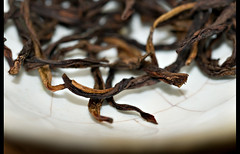
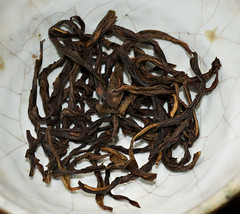

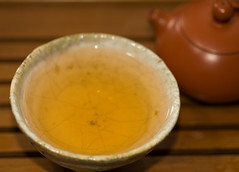
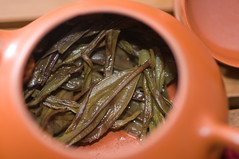
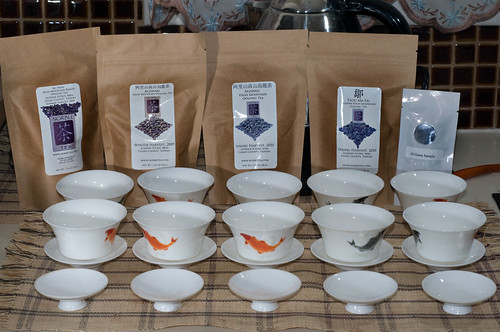

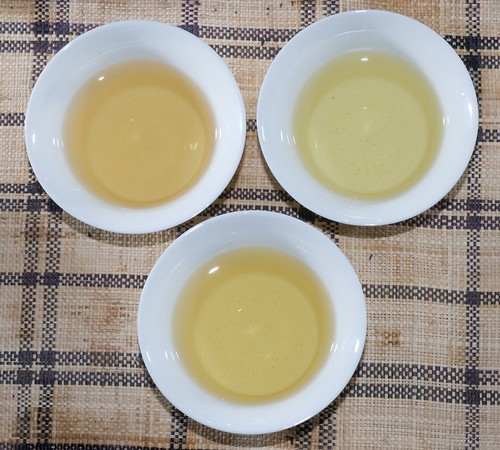

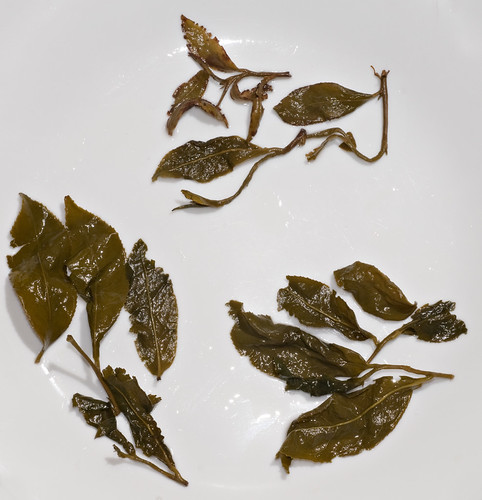
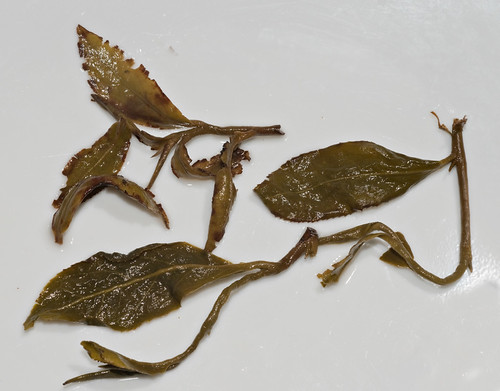

Bernard Clayton Jr., 1916 - 2011
in Cookbooks & References
Posted
The Breads of France was probably the first cookbook I read cover to cover. It's a travelogue, a baking journal, and an endless source of ideas and inspiration. I've been working with it--making notes all over the pages, breaking the spine, taping it together, and having a dialogue with it--for 20 years. I even wrote him a fan letter with a variation I'd come up with on one of his recipes, and got a very nice reply.
I also have his the revised Complete book of breads and Complete book of pastry on my shelves, and though I rarely follow the recipes precisely from the Complete book of breads--I get inspired but usually end up blazing a slightly different trail, being a wholemeal crank and all--I use the base pastry preparations from the Complete book of pastry frequently with little variation.
I still haven't made Normandy Beaten Bread yet. I think it's time for some buttery dough to be pounded in his memory.